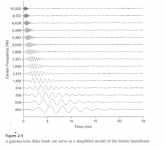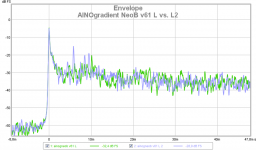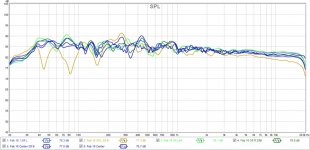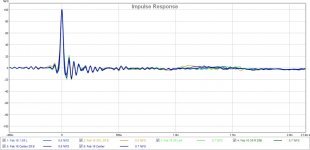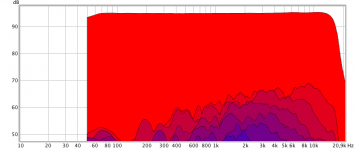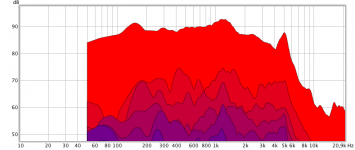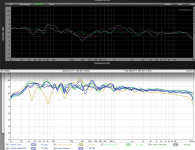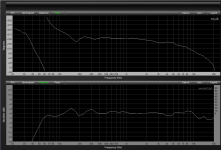With respect to "room correction", one needs to understand first that the acoustic analysis software used to measure the "room" requires frequency dependent windowing (FDW). Otherwise, with a fixed window size, one can only measure one point in time and therefore can only correct one point (or position) in time.
FDW is a good start to the problem, but it is not ideal. The ears temporal aspects are not a linear effect, which the FDW is. And somewhere below Schroeder the window should go full width to get the steady state.
This brings me to another point - Markus, thanks for the reference on that book on "Auditory Neuroscience" It is really quite excellent. A very good survey of the latest research and understanding in hearing. I was particularly impressed with Fug 2.4. This figure explains so much. Note how the temporal aspects (FDW) are not linear with frequency. Also note that of the 15 CB filters shown 12 of them are above 700 Hz. The cochlea is dominated by frequencies above 700 Hz. There is so much to see in this figure.
I used this book to create my own set of gammatone filters to use in my polar map program.
Attachments
This is physically impossible. One can ideally correct an impulse response only at a single point. One can optimize the response over an area by averaging several measurements, but then all time information is lost. EQ should not be done on a speaker in a room for anything but the direct field. For the direct field spatial averaging is not desirable, but polar response control in the loudspeaker is. But this is best done outside of the room. Where this cannot be done outside of the room is at LFs below Schroeder. There only steady state sound is meaningful and must be done in-situ.
You can correct the main phase shifts of the speaker itself (not the room), based on "anechoic" (or gated) measurements or theoretical information (like BR tuning frequency, etc.). This is the approach I use in rePhase.
Correcting the source independently of the room can also possibly ease any other measurement or correction (including the room) that would be done afterward, as the energy of the impulse emerging from the source is closer to a dirac, instead of being already spread in time with decreasing frequency. Gating for example will be easier to get right, as all frequency will "start" at the same time.
It will also probably be easier to obtain a more clear "silence zone" between the direct signal and the first reflexions.
FDW is a good start to the problem, but it is not ideal. The ears temporal aspects are not a linear effect, which the FDW is. And somewhere below Schroeder the window should go full width to get the steady state.
This brings me to another point - Markus, thanks for the reference on that book on "Auditory Neuroscience" It is really quite excellent. A very good survey of the latest research and understanding in hearing. I was particularly impressed with Fug 2.4. This figure explains so much. Note how the temporal aspects (FDW) are not linear with frequency. Also note that of the 15 CB filters shown 12 of them are above 700 Hz. The cochlea is dominated by frequencies above 700 Hz. There is so much to see in this figure.
I used this book to create my own set of gammatone filters to use in my polar map program.
Not only is FDW a good start, as far as *room correction* is concerned, it is a requirement. That takes out REW and other acoustic analysis software that doesn't employ FDW if ones intent is to use the acoustic analysis to design and implement room correction filters. REW thread: Psychoacoustically-Correct room correction - Home Theater Forum and Systems - HomeTheaterShack.com
If you dig a bit further into today's room correction software, one will see that in addition to FDW, a psychoacoustic filter is also implemented, designed to take into account the ears nonlinearities ala "Auditory Neuroscience".
If one is trying to correct for room effects, one needs to use a "room correction" software product that implements FDW, psychoacoustic filters, etc. The etc has been described in various posts I made earlier in this thread.
While there other room correction products, the ones I have used personally are: Acourate, Audiolense, DRC, and Dirac. If one looks at what's common between these DSP software products, it will become apparent why PEQ will never work for "room correction".
It also explains why I can get both the frequency and time domain responses (overlays attached) measured at 6 different locations across a 6' x 2' grid, using REW software to measure each "point" location.
Getting past PEQ, and into real room correction, one will also find that linear phase FIR filters measure and sound better than minimum phase filters. I linked to the science in earlier posts. As soon as one hears a linear phase FIR filter corrected system, (compared to minphase) you will know why.
Before anyone jumps on me for that last comment, please provide an acoustic measurement of a linear phase FIR filter corrected sound system (like the impulse response attached) to show one has actually measured and heard such a system.
Good luck, Mitch
Attachments
You can correct the main phase shifts of the speaker itself (not the room), based on "anechoic" (or gated) measurements or theoretical information (like BR tuning frequency, etc.)
Yes, of course, but shouldn't a good speaker do this already?
Getting past PEQ, and into real room correction, one will also find that linear phase FIR filters measure and sound better than minimum phase filters. I linked to the science in earlier posts. As soon as one hears a linear phase FIR filter corrected system, (compared to minphase) you will know why.
Good luck, Mitch
Is there real science here and not just "listening"? Are there any per reviewed publications that you can reference to support this rather substantial claim? I have wondered about this myself, but I don't except "listening" as proof of anything. It has to be based in science and tested with double blind statistically stable results. Otherwise it is just another "belief" and most likely wrong.
It will also probably be easier to obtain a more clear "silence zone" between the direct signal and the first reflexions.
Again, yes, of course. But isn't the 64K question: If I have a perfect speaker should one "correct" this speaker in the room with room EQ? Shouldn't it be a moot point in that case? If you are correcting reflections then that's wrong - period, because this is extremely location specific. (Unless you are talking about car interiors where you have no other options. I have been doing this in cars for decades.)
If one looks at what's common between these DSP software products, it will become apparent why PEQ will never work for "room correction".
Why not? It's a minimum phase filter correction. It does work. Look at the various Dirac papers that show just that (e.g. "Spatially Robust Audio Compensation Based on SIMO Feedforward Control", IEEE TRANSACTIONS ON SIGNAL PROCESSING, VOL. 57, NO. 5, MAY 2009). Mixed phase CAN work better but this depends largely on the room.
My room decays to complete ambiance in less than 300ms, despite highly reflective walls with lots of brick, glass, and 3/4" wood paneling. Room is well furnished, with wall to wall wool carpet and carpet padding, acoustic tile ceiling, and ceiling broken up by three wooden beams:
Looks ike your room is highly damped not only because of the acoustic tiling but because of glass and false (?) brick wall that can be effective low frequency absorbers.
What I don't understand is the difference in room decay between your woofer and corrected speaker response:
(Slice interval 20ms, window 20ms, rise time 0,1)
Attachments
Getting past PEQ, and into real room correction, one will also find that linear phase FIR filters measure and sound better than minimum phase filters. I linked to the science in earlier posts. As soon as one hears a linear phase FIR filter corrected system, (compared to minphase) you will know why.
What if i make a FIR minphase correction? It is no problem to do so, and the magnitude response looks exactly like the linear phase correction.
Not only is FDW a good start, as far as *room correction* is concerned, it is a requirement. That takes out REW and other acoustic analysis software that doesn't employ FDW if ones intent is to use the acoustic analysis to design and implement room correction filters. REW thread: Psychoacoustically-Correct room correction - Home Theater Forum and Systems - HomeTheaterShack.com
If you dig a bit further into today's room correction software, one will see that in addition to FDW, a psychoacoustic filter is also implemented, designed to take into account the ears nonlinearities ala "Auditory Neuroscience".
If one is trying to correct for room effects, one needs to use a "room correction" software product that implements FDW, psychoacoustic filters, etc. The etc has been described in various posts I made earlier in this thread.
While there other room correction products, the ones I have used personally are: Acourate, Audiolense, DRC, and Dirac. If one looks at what's common between these DSP software products, it will become apparent why PEQ will never work for "room correction".
It also explains why I can get both the frequency and time domain responses (overlays attached) measured at 6 different locations across a 6' x 2' grid, using REW software to measure each "point" location.
Getting past PEQ, and into real room correction, one will also find that linear phase FIR filters measure and sound better than minimum phase filters. I linked to the science in earlier posts. As soon as one hears a linear phase FIR filter corrected system, (compared to minphase) you will know why.
Before anyone jumps on me for that last comment, please provide an acoustic measurement of a linear phase FIR filter corrected sound system (like the impulse response attached) to show one has actually measured and heard such a system.
Good luck, Mitch
Mitch,
Room correction only occurs for one point in room, for given source and receiver location.
Your measurement in 2' x 6' region show this very clearly. Even with 1/6 octave smoothing the reflection contribution changes bass response in predictable fashion. Your IR plots show about 2ms of response, this is dominated by HF portion of response, where majority of energy is of speaker's direct response. This is where your FR plots are smoothest. They show that speaker has uniform coverage of measurement region. Even with 1/6 octave smoothing, HF responses show ripple variation due to driver diaphragm profiles, waveguide profiles, and room reflections not removed by FDW.
With respect to "room correction", one needs to understand first that the acoustic analysis software used to measure the "room" requires frequency dependent windowing (FDW). Otherwise, with a fixed window size, one can only measure one point in time and therefore can only correct one point (or position) in time.
This is completely wrong. A recording is a continuous measurement in time of energy levels with constrained bandwidth. For finite time interval, exact same information is contained in spectral interpretation. Small moving window across large time interval reveals reflections with spectral intensities constrained by size of sliding window, and chosen windowing function for the window. All spectral results based on time domain are from fixed time reference and calculation including all points in time before and after reference point with length (number of points) determined by size of FFT and applied windowing function to smooth out ends. With complete IR starting and ending in noise floor, rectangular window even works well.
Frequency dependent windowing is tool for progressively gating out reflections with increasing frequency. Windowing method is applied to complete IR response in frequency domain, then modified frequency domain is transformed back into time domain to get a modified IR representation.
Core of software, often dubbed "Room Correction", is not frequency dependent windowing, or psychoacoustic filter (this is primarily nonsense, in your posts, this is selection of a classic house curve with knee between 1-4kHz with HF roll off of several dB/octave), but instead is capacity of software to generate inverse transfer function for constrained bandwidth. For modal behavior measured at listening position, PEQ of matching Q, center frequency and inverse amplitude is perfect example. Correction software takes bin by bin frequency response amplitude and phase and generates a sine wave with amplitude and phase that becomes correction. Whole new inverted spectrum is then transformed back to time domain, for filter that is readily convolved with source signal. DRC package contains Kirkeby inverse routine. All other FIR correction software contains similar routine.
With measurement at listening position, direct to reflection ratio is small. This results in specific reflections at given frequencies to have sum close to, and often greater than amplitude of the direct sound. The inverse filter in this situation provide near perfect correction that is equivalent to very high Q PEQ filter, and correction is only valid at measurement point. For given frequency measurement point for given frequency is sphere <<1/4 wavelength.
With long IR, and correspondingly long window for transformation into frequency domain, group delay plot becomes highly erratic due to all the reflected content. Juhazi's GD results demonstrate this quite clearly:
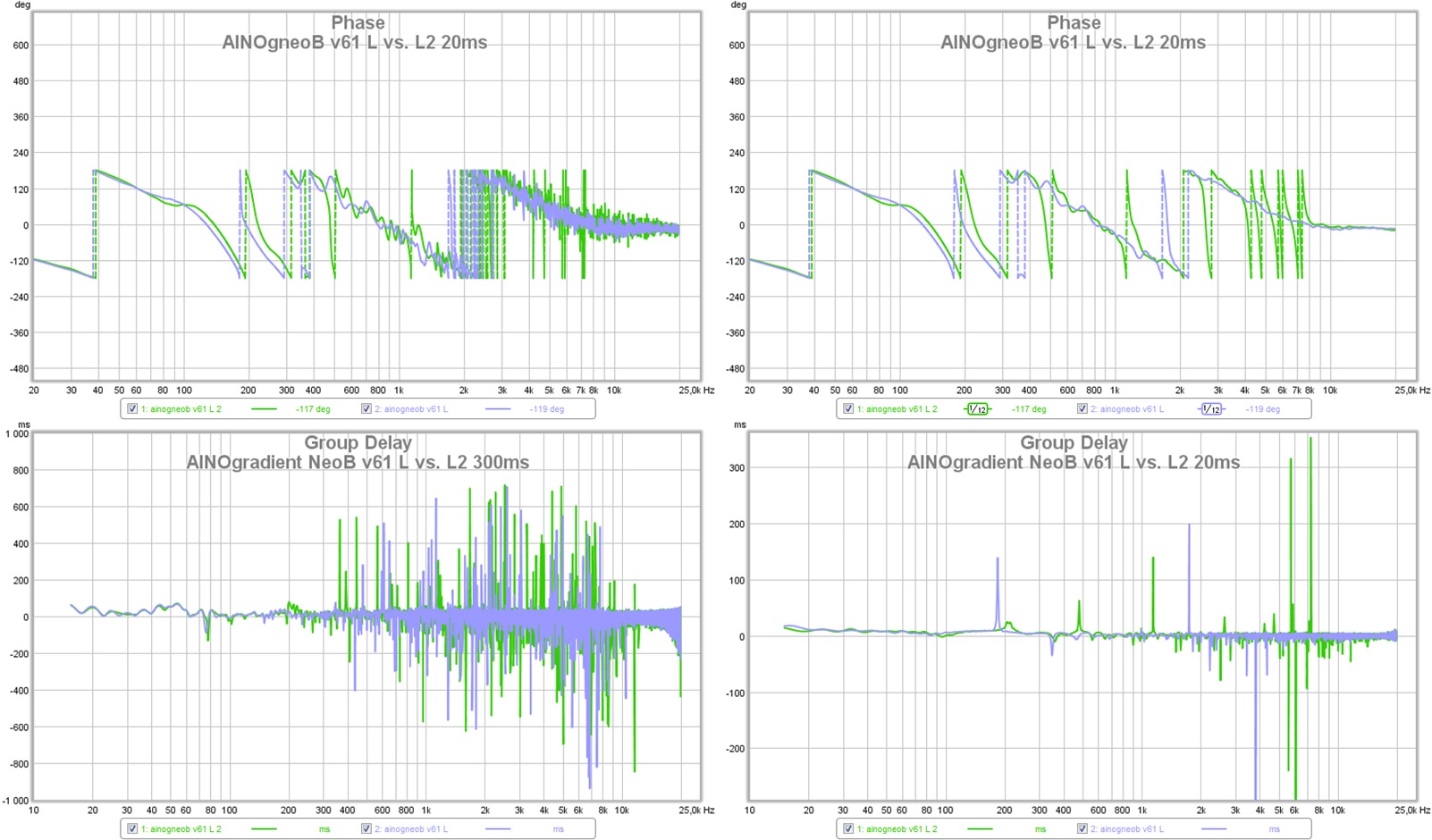
Even with only 20ms window, virtually all first boundary reflections are present, and with direct/reflected ratio at his measurement point numerous frequencies have GD of greater than 100ms magnitude. Passing this through Kirkeby type inversion yield correction that is typically unusable, with hideous amounts of ringing at all but microphone position. Insertion of head at measurement position shades and focuses various reflections at higher frequencies, making result totally useless. Multiple phase wraps grouped together in above picture tell same story. With Juhazi's 300ms results, Kirkeby inversion constrained to below 300Hz will provide generally useful result. Passage of IR through FDW with well chosen parameters increases frequency range for which spectral inversion will provide good results.
FDW followed by spectral inversion results primarily in speaker correction, and modal correction for low order room modes/reflections.
My demonstrated correction does not use FDW, or any house curve psychoacoustic type stuff. Criteria for information bandwidth is flat response. Reflections are highly down weighted by high direct/reflected ratio due to close reference measurement. Speaker design has minimal baffle impact, close driver placement relative to crossover frequency.
Here is GD for raw tweeter measurement using 20ms Blackman-Harris 4 term windowing:
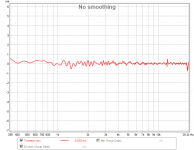
Unlike Juhazi's measurement, this one is suitable for spectral inversion without any additional treatment. FDW would add little if any benefit.
^
The difference is in the time domain. In my mind this is at the core of the problem. It's not about minimum phase vs. mixed phase, it's about what needs to be corrected and what type of filter is capable of doing it in a spatially robust manner.
It seems to me that this all comes down to: Can we hear the difference between a minimum phase and a non-minimum phase response if both have the same amplitude response.
Most likely there is a threshold above which it is audible and below which it is not. Is that threshold known? I asked this (or something like it) before but never got an answer.
Griesinger claims that phase in the 700 Hz -> 7 kHz region is important for localization. He correctly asserts that early reflections will destroy this phase even if the amplitude is not strongly affected. But what about a small non-minimum phase shift as would occur from a crossover. Is this audible or below detection? It is not a aspect of the problem that I have studied in any depth. Has anyone done a scientific investigation of this? Or are we, as usual, shackled to the "it sound good to me" lack of data?
I know I've come across at least a couple of real experiments on that, yes. IIRC, practically relevant crossover-ish shift could be shown audible in listener tests with training, barely, but identifying "correct" was not achieved except with test signals. I'm not gonna search for it now, it would take more effort to make any ultimate claims, so it's not that interesting unless someone thinks it is extremely important, rather than a perfectionist pursuit that might have some small value.But what about a small non-minimum phase shift as would occur from a crossover. Is this audible or below detection? It is not a aspect of the problem that I have studied in any depth. Has anyone done a scientific investigation of this? Or are we, as usual, shackled to the "it sound good to me" lack of data?
I have tried my own ABX tests with digitally creating crossover phase shift. Didn't come up with anything that concerned me much until 96dB/octave (plus 24dB/octave playback speakers), at which point I wasn't sure if it was phase shift or FIR issues or both, and I was already way past what I had set out to test so I wasn't interested in refining it.
Most likely there is a threshold above which it is audible and below which it is not. Is that threshold known? I asked this (or something like it) before but never got an answer.
Me neither and exactly the reason why this thread exists
I would love to see some real data on this issue. Even if it is not super significant, with DSP it is almost as easy to make a linear phase crossover as it is to make a normal one. Which one is going to yield the best perception? That is a very real question. If it has not been done then I think Lidia might find it a useful experiment. It would be relatively easy to do.
It seems to me that Griesinger's claims are more related to interaural phase variations than to the intrinsic phase of signals within a channel (see his LOC phase measurement).Griesinger claims that phase in the 700 Hz -> 7 kHz region is important for localization
In Fastl-Zwicker, Psychoacoustics, 7.3, phase distortion is said to be audible with three sine tones which frequencies are just within a critical bandwidth. The phase distortion of crossovers is allways very subtle but in certains cases it can be ABXed, ie LR24 phase distortion is audible with the triple tone (ie central F from 1 to 4kHz).But what about a small non-minimum phase shift as would occur from a crossover. Is this audible or below detection? It is not a aspect of the problem that I have studied in any depth. Has anyone done a scientific investigation of this? Or are we, as usual, shackled to the "it sound good to me" lack of data?
With music, most standard filters have group delays under threshold of audibility.Most likely there is a threshold above which it is audible and below which it is not
It is easy : just download rephase http://sourceforge.net/projects/rephase/ and convpare http://www.ohl.to/audio/downloads/convpare.zip.If it has not been done then I think Lidia might find it a useful experiment. It would be relatively easy to do.
With rephase, you create any phase distortion you want and with convpare, you can listen and compare with/without this phase distortion added (the internal generator has even the triple tone included).
Last edited:
Mitch,...If one looks at what's common between these DSP software products, it will become apparent why PEQ will never work for "room correction".
It also explains why I can get both the frequency and time domain responses (overlays attached) measured at 6 different locations across a 6' x 2' grid, using REW software to measure each "point" location.
Getting past PEQ, and into real room correction, one will also find that linear phase FIR filters measure and sound better than minimum phase filters. As soon as one hears a linear phase FIR filter corrected system, (compared to minphase) you will know why.
Before anyone jumps on me for that last comment, please provide an acoustic measurement of a linear phase FIR filter corrected sound system (like the impulse response attached) to show one has actually measured and heard such a system.
Good luck, Mitch
I have measured a self powered bi-amped Mackie HD1521 which uses FIR filters down to around 200 Hz (latency for live use would become an issue if implemented lower) and it sounded far better than I would have expected considering the drivers and horn used.
At the time (2009) I was amazed by the flat phase response, being unaware of FIR, I had never measured a multi-way speaker with as flat phase over as wide a range.
I use an Alesis DEQ830 (30 band 1/3 octave digital equalizer) to equalize my stereo speakers, a pair of 8" with dome tweeters and a 2x12" sealed sub.
The frequency response over the width of my couch show similar deviations as your measurements using FIR filters, though my system shows wrapping phase response typical of a three-way system.
The green trace is the center listening position, purple left of center, and white far left of center (near the side wall), four foot distance between center and far left. The center listening position is also room center, couch is up against the left wall.
Although one can argue that linear phase "sounds better", from a frequency response standpoint, it does not appear to be measurably better.
Having compared speakers that measure flat but have smoothly wrapping phase response to ones that measure flat with more linear phase, I can't tell the difference, so I have not bothered to change to a FIR based system.
Art
Attachments
Last edited:
- Status
- This old topic is closed. If you want to reopen this topic, contact a moderator using the "Report Post" button.
- Home
- General Interest
- Room Acoustics & Mods
- Room Correction with PEQ
